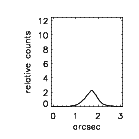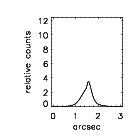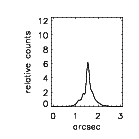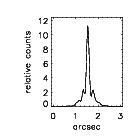Adaptive optics with a
Laser
For
Astronomy
Results with the laser: 23% Strehl
June 1999
A series of excellent nights during a technical run in June allowed ALFA to
make huge progress in correcting the wavefront using a sodium laser guide
star in order to reach high Strehl ratios.
The superb performance achieved shows the exciting future potential of
adaptive optics with laser guide stars.
For these results,
summarised here, the laser was pointed on-axis and imaged on the
wavefront sensor through the 5x5 lenslet array at a frame rate of 75 Hz.
This allowed 18 high order Karhunen-Loeve modes to be corrected with a
bandwidth of around 12 Hz.
A natural star (SAO 68075), 10 arcsec off-axis to avoid any of its light
reaching the WFS, as used to correct tip-tilt motion at 65 Hz.
A series of 40 consecutive images were taken of the star in the K-band
(2.2 microns) on the Omega-Cass camera.
Each integration was 5 sec, and the only processing performed was
sky-subtraction and bad pixel removal.
In particular, no shift-and-add or deconvolution techniques were applied.
Frames were added together directly to produce long exposure images.

| 
| Open loop 50 sec K-band image of SAO 68075. The seeing indicated a FWHM
resolution of 0.65'', an extremely good value.
|

| 
| 50 sec image with tip-tilt corrected on the star. The FWHM has decreased to 0.49''.
|

| 
| All 40 images added together to give an effective 200 sec exposure,
with tip-tilt corrected on the natural star and high order correction on
the laser star. The FWHM is now only 0.19'' and the Strehl ratio is 12.8%.
These values show what might be expected for long integration times.
|

| 
| During the very best 10 sec, a Strehl ratio of 23.0% was reached,
and the PSF is diffraction limited (0.14'').
The first diffraction ring is clearly visible.
|
What is a Strehl ratio ?
A Strehl ratio, or simply Strehl, is the ratio of the peak intensity of the
measured point-spread function (PSF) to the theoretical maximum.
In practice, it is only possible to measure the peak intensity integrated
over one pixel, but with small pixels (in this case 0.04'') the derived
Strehls are very similar to the absolute ones.
The theoretical PSF depends on both the diameter of the telescope's main
mirror (and its central obscuration) as well as the wavelength at which
it is measured.
Because the AO corrected PSFs have a `core+halo' shape, the FWHM very quickly
approaches the diffraction limit even when the Strehl ratio is relatively
small. Thus, if only high resolution is required, a Strehl of 10-15% might
be satisfactory.
But if you are trying to detect faint objects then you want the Strehl as
high as possible: even with a Strehl of 40% only 1/4 of the energy is in a
diffraction limited core, the rest is in a broad halo making detection of
nearby objects harder.
However, either of these cases are far better than a seeing limited PSF:
for K-band observations on the 3.5 m telescope at Calar Alto, in 1'' seeing
the Strehl ratio is only 2.5% and only 1/20 of the total
energy is in the same core region.







